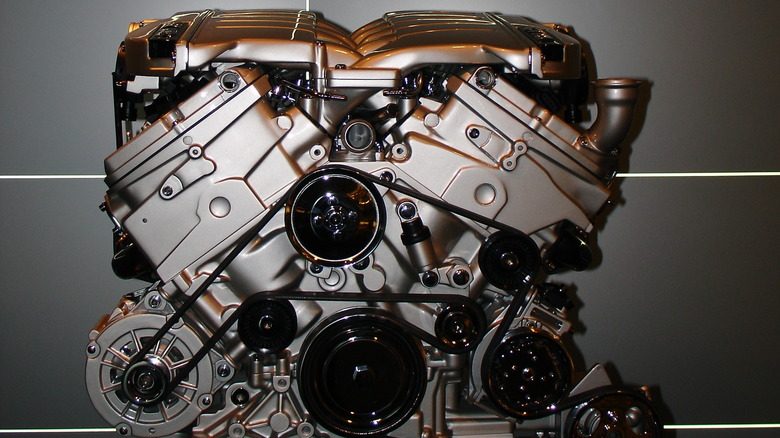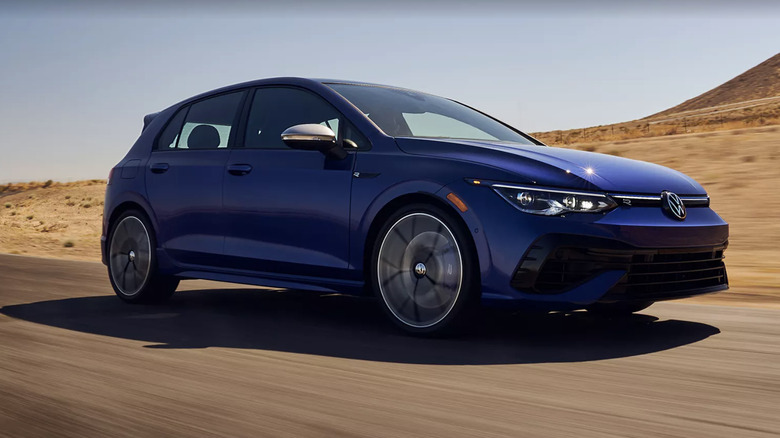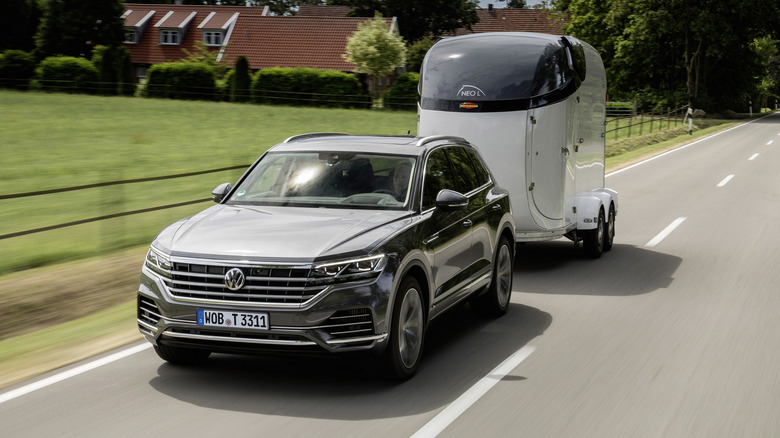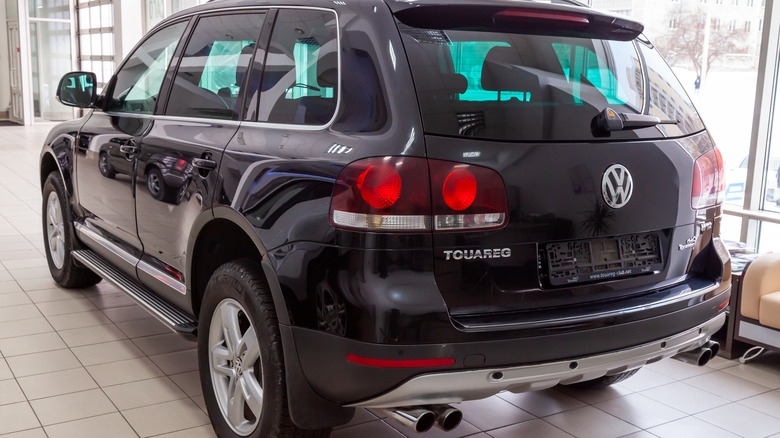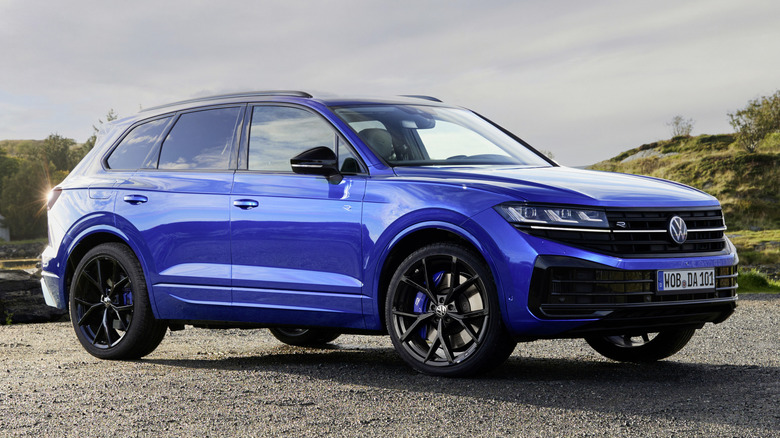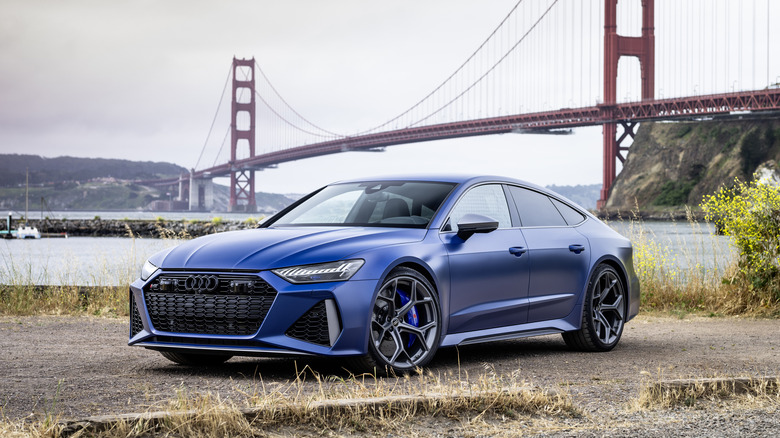5 Of The Most Powerful Auto Engines Ever Built By Volkswagen
The name Volkswagen is not normally associated with powerful engines; in fact the brand has long been associated with underpowered, but lovable classics. Those of us who have owned or been stuck behind a vintage Beetle or any of the multiple iterations of the Bus, Transporter, or Kombi vans know that those beauties can be frustratingly slow. However, not every VW chugs along like the 1949 Beetle, which was the first of that model to make it to the United States. VW's powerplants evolved quickly throughout the rest of the 20th Century and into the 21st, and the Volkswagen Group has since grown to include luxury and performance brands like Audi, Lamborghini, and Porsche.
We don't have to dip too deeply into the catalogs of those labels to find some large and potent powerplants, though. The Volkswagen badge has fronted some impressive engines in recent years, as have those of its subsidiaries. Here are a fistful of the highest-horsepower engines ever built by Volkswagen for cars or SUVs sold under one of its brands.
[Featured image by Hasse A via Wikimedia Commons | Cropped and scaled | CC-BY SA 3.0]
The Golf R had a high-powered four-cylinder engine
VW introduced the Golf in 1974 as the Beetle's successor, and the Golf's production of over 37 million units would eventually qualify it as the top-selling European model in history. Throughout most of its run, it was known more for efficiency and reliability. However, during the eighth generation, VW introduced the performance-oriented Golf R, which originally had a 315-horsepower inline-4 that Car and Driver clocked at 4.1 seconds in the 0-60 miles per hour sprint.
For the 20th Anniversary edition of the Golf R that appeared for the 2023 model year, European buyers got a specially tuned version of the R's 2.0-liter four that made 329 horses. American buyers had to settle for a version of that same engine that "only" produced 315 horsepower, but if that doesn't provide you enough juice for a car that weighs less than 3,500 pounds, you need driving lessons. SlashGear's Chris Tonn reviewed the Golf R in the Fall of 2022 and found that the potent engine paired well with the U.S market-only six-speed manual transmission. He concluded that the Golf R's "surefooted all-wheel drive and resulting heroic performance on unpredictable roads yield a rewarding drive."
The Touareg V8 TDI produced 416 horsepower
Volkswagen's reputation as a diesel engine producer took a hit with the Dieselgate scandal that affected vehicles sold through 2016, but that didn't stop VW from producing diesel-powered engines. For the 2019 and 2020 model years, buyers of the VW Touareg SUV could select a 4.0-liter V8 diesel engine with twin turbochargers, which produced 416 horsepower and a spine-jiggling 664 pound-feet of torque. That latter number came at just 1,250 revolutions per minute, giving the Touareg a low-end strength that allowed it to tow more than 7,700 pounds when equipped with a trailer brake system.
Matt Martel of Business Desk New Zealand noted that the engine was originally intended for the high-end Bentley Bentayga, but VW had a change of heart and put it in the Touareg instead. The Touareg's curb weight of almost 5,400 pounds and the powerful engine makes this a thirsty vehicle, though. Encycarpedia reports average fuel economy of 24.5 miles per gallon, but the 0-60 time of 4.9 seconds and top speed of over 150 miles per hour can help you forget about how much fuel you're burning.
The early 2000s Touareg W12 made 444 horsepower
Long before VW outfitted the Touareg with a V8 diesel engine, an even more powerful version of the refined SUV was available. VW introduced the Touareg at the 2002 Paris Motor Show, then brought a W12 Sport version back in 2004 as a limited edition model. It shared a 444 horsepower W12 engine with the Phaeton W12, a top-of-the line sedan that sold for just over $65,000 (more than $110,000 in 2024 dollars).
The Touareg W12 Sport was initially intended to be issued in a limited run of 500 units to German and French buyers, but was eventually produced in larger numbers and also sold in Japan. The 444-horsepower SUV was on those markets from 2004 through 2010, and its luxury sedan cousin enjoyed a run from 2005 through 2011. Like the V8 TDI Touareg, the W12-powered Phaeton and Touareg gulped fuel like the overweight yaks they were. The 5,269-pound Phaeton delivered about 16.3 miles per gallon combined, and the Touareg W12 — at almost 5,500 pounds — provided a gallon and a half per mile less.
The 2021 Touareg R had a 456-horsepower hybrid V6
For the 2021 Touareg R, Volkswagen dropped in a hybrid powerplant that combined a turbocharged 3.0-liter V6 gas engine that produced 335 horsepower with a 134-horse electric motor. Together, the hybrid engine setup in the Touareg R ended up yielding a total output of 455 horsepower and 516 pound-feet of torque. The Touareg R was only available in Europe, so American customers who wanted the 455 horsepower had to walk across to the Porsche side of the dealership lot, and talk to a salesperson about a Cayenne E-Hybrid.
That meant ponying up a minimum of $88,900 — and more than $100,000 if you added enough options. The 2024 update to the Cayenne E-Hybrid brought an increase to 512 horsepower and 553 pound-feet of torque, which enabled a 0-60 mph time of 4.4 seconds, and a quarter-mile run of 13 seconds on the nose. The base price jumped more than $10,000, though, and the coupe version will set you back a minimum of $104,000.
The Audi RS7 has a 621-horsepower V8
Audi has long sat slightly above the parent VW brand in terms of luxury and performance, but the 2024 RS7 takes things to a new level in both respects. At the RS7's heart sits a 4-liter V8 with twin turbochargers that boost output to an unholy 612 horsepower and 627 pound-feet of torque. That utterly obliterates the long-outdated muscle car standard of one horsepower per cubic inch of displacement, considering that four liters measures out to just 244 cubic inches and a tiny bit of change.
The RS7 matches that engine with an eight-speed Tiptronic automatic gearbox that helps you launch the sport sedan from 0-60 in just 3.3 seconds, a time our Chris Davies said "frankly, feels like a conservative estimate." He added that the exhaust was perfectly suited to the potent engine, delivering a "throaty, gurgling bellow that unlocks above the 3,000 rpm point or thereabouts, taking on a saw-toothed howl that reminds us why big gas engines still have their appeal."
